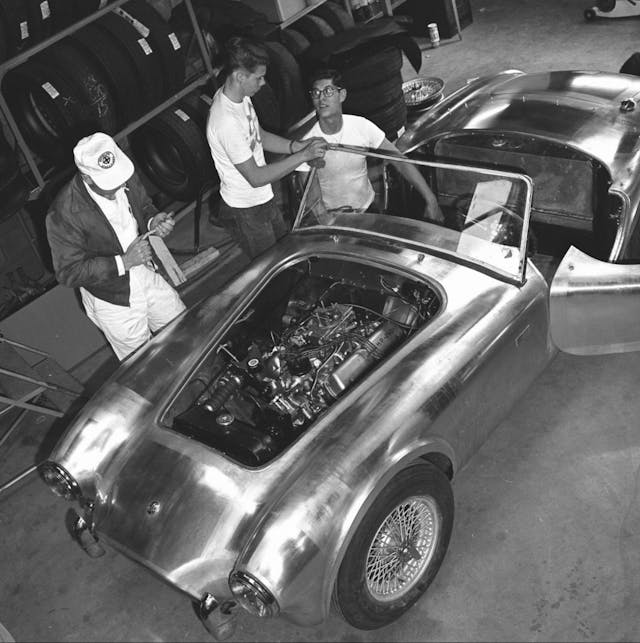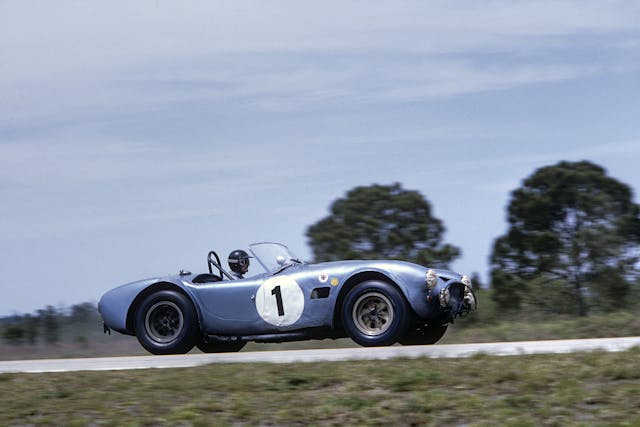Media | Articles
The life and death of “The Turd,” Shelby’s first 427 prototype
Meeting this book deadline almost killed me. Late last year, inspired by an idea pitched by Colin Comer, Hagerty assigned me to write a long-form feature about Shelby American, pegged to the then-upcoming 60th anniversary of the Cobra. After I submitted the piece, I pitched a book proposal to Octane Press, and the editor jumped all over it. The problem? We were determined to get the book out in 2022 to take advantage of the Cobra anniversary. That meant an insanely compressed schedule. The challenge was to produce a book that didn’t simply regurgitate material that can be found in dozens of other books covering Shelby, the Cobra, the Ford GT, the GT350, and so on. I tried to showcase the work done by the people whose names haven’t always been featured in these histories. Sadly, most of the major players are long dead. But I did my best to bring their stories to life.
[Excerpted from Shelby American: The Renegades Who Built the Cars, Won the Races, and Lived the Legend, to be published on August 12, 2022. Priced at $35, the book is available at www.octanepress.com, on Amazon or in bookstores.]
Ted Sutton had just created a monster.
Sutton was a resourceful young mechanic at Shelby American, the company Carroll Shelby had assembled in Southern California to build the Cobra. Engineered by motorsports savants and equipped with a 289-cubic-inch Ford V-8, the Cobra was the most fearsome sports car in the world, circa 1964. But Shelby wasn’t content with what he had wrought; he wanted something even more menacing. Sutton was assigned to play mad scientist. Performing surgery in a broad, red-brick building nestled incongruously in a blue-collar enclave in Venice, he retrofitted a standard Cobra with a big-block 427. When the conversion was complete, he did what any self-respecting 25-year-old gearhead would have done: He climbed into the cockpit, cranked the ignition and careened through the neighborhood, breaking the tires loose at every opportunity and sending gloriously obnoxious blasts of big-block bedlam out the straight pipes. When he got back to the shop, he heard his name being called. Mr. Shelby wanted to see him.
Gulp.
Marketplace
Buy and sell classics with confidence
Recovering from knee surgery, Shelby hobbled down the stairs from his office. Sutton waited glumly, sure he was about to be fired. Instead, Shelby asked him, “Was that you that drove that car?” Sutton warily acknowledged that it was. “Well, how did it go?”
“It was just fine, sir,” Sutton said.
“Let’s see. You wanna ride along?”
Sutton explained that he’d pulled out the passenger seat so he could run the down tube for the U-shaped roll bar through the cockpit.
“Well, you can sit on the floor, can’t you?”

As soon as Sutton wedged himself into place, Shelby started slinging the Cobra through a nearby field in four-wheel drifts and winding out the 427 to redline as he blew past stop signs. Sutton hadn’t adjusted the brakes or swapped out the narrow tires and wimpy wire wheels that had been mounted on the car while he was building it, and it was only by the grace of God that there were no schoolkids or other pedestrians happening past as they skirted around a trailer park. As he desperately hung on, with one hand wrapped around the roll bar and the other clutching Shelby’s crutch, Sutton kept thinking that he was trapped inside a flimsy deathtrap with a certifiable lunatic. “I was absolutely purple by the time we got back to the shop,” he said. “To say he scared the shit out of me would be a gross understatement—I was truly afraid for my life. I just knew we were going to hit something or someone.”
Shelby killed the ignition while Sutton lingered in the car, drained and ashen-faced. “That’s real nice,” Shelby drawled nonchalantly before limping back up to his office.

In February 1964, Sutton’s baby was track tested for the first time at Riverside International Raceway by Ken Miles and Bob Bondurant. Other than a bare-metal nosepiece, which had been reworked to accommodate a larger grille, the car looked like little more than a grungy, red 289 Cobra. At this point, it betrayed none of the swagger that would become the signature of the big-block Cobra—no brawny fender flares, no wide-track chassis, no scoops or louvers. Dainty wire wheels and street tires completed the sheep-in-wolf’s-clothing appearance package.

Despite ferocious acceleration, the 427 didn’t impress Miles or Bondurant. The handling was mushy, which is exactly what you’d expect of a ponderously nose-heavy car. And the hybrid looked very much like a work in progress. Shelby American mechanic and resident wit Garry Koike came up with a moniker that reflected the car’s flaws and the shop’s sensibilities: “The Turd.” When a magazine writer asked him about the name, a publicity-conscious Miles gave it a positive spin, saying it referred to the car’s ability to shit on the competition. But the guys who worked on it knew better. “We called it The Turd,” John Morton explained, “because it was.”
Miles was scheduled to give the 427 Cobra its race debut in the 24 Hours of Sebring, and Morton was determined to be there. An aspiring racer who was climbing the SCCA club-racing ladder, Morton had been hired by Shelby as a janitor and was now working as a fabricator. He and fellow mechanics Jeff Schoolfield and John Shoup agreed to drive to and from Florida on their own nickel in return for a twenty-five-dollar-a-day gig at the track to work as night watchmen. Ah, to be twentysomething again! Crammed in a Karmann Ghia, they endured fifty-four consecutive hours on the road, stopping only for food and gas, before collapsing in a dumpy motel at four in the morning. A few hours later, at tech inspection, Morton ran into Miles.
“Do you have an FIA license?” Miles asked him.
Morton stared incredulously at him. Of course, he didn’t have an FIA license. All he had was an SCCA regional license, which was the motorsports equivalent of a high school diploma, and he didn’t have it with him. But Miles wanted Morton in reserve just in case he needed a co-driver. On the spot, Miles wrote out a brief letter of recommendation. To Morton’s amazement, he was given a license, no questions asked. Like Miles, he figured the odds of him actually getting to race were infinitesimal. Not counting Miles, there were eight other drivers on the Shelby American team, and one of them surely would be available if and when Miles felt he had to get out of the car. But just in case, Morton bought a race suit from a trackside vendor for fifteen dollars and arranged to borrow a helmet from a motorcycle racer.
Unlike Daytona, Sebring was open to prototypes as well as GT cars, and Ferrari had shown up with its latest 330 Ps. Still, Miles was third-fastest in the 427 Cobra—which was itself classified as a prototype since it hadn’t been homologated—during the early stages of the first practice session. Then, he skidded off the track and clobbered what everybody later delighted in describing as the only tree for miles in any direction. Miles, who was known as “Teddy the Teabagger” because of his insistence on enjoying a “cuppa” in the morning, was instantly renamed “Teddy the Treebagger.” Looking at the wreckage, racer Phil Hill said, “Looks like you got a little behind in your steering.”

The crash destroyed the Turd’s right front suspension, bent the frame and the headers, and knocked the hell out of the body, which hadn’t looked that great to begin with. It also badly bruised or broke several of Miles’s ribs. (He refused to see a doctor for fear that he’d be denied permission to race.) Still in his race suit, he, Morton, Schoolfield, Sutton, Koike and Jim Culleton pulled an all-nighter bending, hammering, and otherwise whipping the car back into shape. The next morning, Shelby, still recuperating from knee surgery, rolled up in a wheelchair and introduced Sutton to a big, burly man with a round face.
“This is John Holman,” Shelby said. “He would like you to put one of his new engines in the car.” Sutton and his exhausted crew used an airplane crane designed for pulling engines out of DC-3s to manhandle a full-on NASCAR 427 into the hastily repaired Turd. Miles never posted a time in qualifying, and he started the race in sixty-first position.
Miles had nothing but trouble with The Turd—first, brake problems, then a blocked fuel line, not to mention a frustrating disinclination to head in the direction it was pointed. But the car refused to die, and since all the other Cobras were still running, it looked like Morton might have to drive after all. Shelby called him over. “John,” he said, “do you know this track?”
Moment-of-truth time. “Yes,” Morton said. “I’ve been here several times.” As a spectator, that is, but never as a driver. There were parts of the track he’d never even seen.
“If Miles needs relief when he comes in, you be ready, huh?”
Morton was ready. He was also terrified. When Miles pitted, about three hours into the race, Morton approached him in his brand-new race suit and borrowed helmet. “Do you want relief?” he asked tentatively.
Miles gave him a long, withering look connoting . . . what? Disbelief? Amusement? Resignation? After three hours wrestling The Turd around Sebring with a set of broken ribs, he damn well was ready for relief, no matter who provided it. “Yes,” he said.
It was a be-careful-what-you-wish-for moment for Morton. Holding down the heavy clutch, his left foot started shaking so violently that his whole body was vibrating. When he finally eased out of the pits, he was stunned by how badly the car wallowed. “It felt more like a ’49 Buick than a race car,” he recalled. On his out lap, he spun at the hairpin, largely because he didn’t know it existed until he was driving around it. He then spun a second time on the same lap at another turn he’d never seen before. But nobody in the pits noticed. Nobody was even paying attention. Morton survived a brake failure, then a clutch failure and was clicking off respectable lap times when the engine grenaded shortly before dark. The Turd was well and truly dead.















GREAT STORY !!